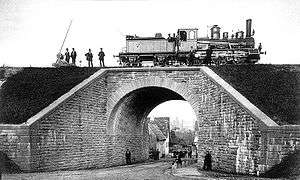Baden IV c
| Baden IV c | |
|---|---|
 | |
| Number(s) | 1 ... 393 |
| Quantity | 59 |
| Manufacturer | MBG Karlsruhe |
| Year(s) of manufacture | 1875 - 1887 |
| Retired | 1901 - 1925 |
| Wheel arrangement | 2-4-0 |
| Axle arrangement | 1B n2 |
| Length over buffers | 14,367 mm |
| Height | 4,150 mm |
| Overall wheelbase | 3,900 mm |
| Empty weight | 31.80 t |
| Service weight | 35.50 t |
| Adhesive weight | 22.50 t |
| Axle load | 11.30 t |
| Top speed | 70 km/h |
| Coupled wheel diameter | 1,680 mm |
| Leading wheel diameter | 1,080 mm |
| Valve gear | Stephenson |
| No. of cylinders | 2 |
| Cylinder bore | 435 mm |
| Piston stroke | 610 mm |
| Boiler Overpressure | 9.0 bar |
| No. of heating tubes | 198 |
| Heating tube length | 3.300 mm |
| Grate area | 1.47 m² |
| Radiative heating area | 6.03 m² |
| Tube heating area | 86.27 m² |
| Evaporative heating area | 92.30 m² |
| Locomotive brakes | Screw brake, later several had counter-pressure brakes |
| Train brakes | Westinghouse compressed air brake |
The steam locomotives of Baden Class IV c were passenger locomotives operated by Grand Duchy of Baden State Railway in the former south German state of Baden.
History
As part of the procurement of 2-4-0 locomotives in the early 1870s, a total of eight batches of Class IV c engines were ordered. These locomotives were used above all on lines with steep inclines in the Black Forest and the Odenwald. As a result, several engines were equipped with a Riggenbach counter-pressure brake.
Design features
Then dimensions of these engines were largely the same as those of the Class IV b. However the double frame was dropped and replaced by a simple plate frame. The engine had a very short wheelbase and as a result good curve-running performance. In addition the carrying axle had a side play of 10 mm. It was returned to its centre position by sloping bearing surfaces (geneigte Doppelflächen). The grate area of the firebox turned out to be very small; as a result its steam generation was not particularly satisfactory. Trials with ribbed tubes did not produce any improvements. The large steam dome sat on the rear boiler section.
The outside wet-steam engine had inside valves and drove the first coupled axle. The wheels were sprung with leaf springs located over the top, that were linked by a compensating lever between the coupled wheels.
The vehicles were equipped with tenders of classes 2 T 8 or 2 T 6.67. Several locomotives were equipped with rearward-facing driver's cabs on tenders. This enabled them to work routes without a turntable.
Sources
- Hermann Lohr, Georg Thielmann: Lokomotiv-Archiv Baden. transpress, Berlin 1988, ISBN 3-344-00210-4
See also
External links
- There is a relevant English-language forum at Railways of Germany